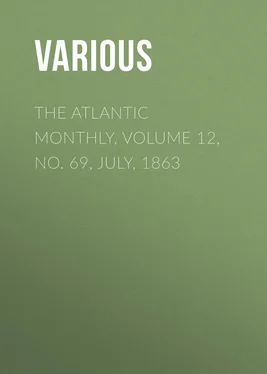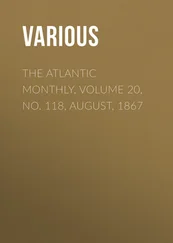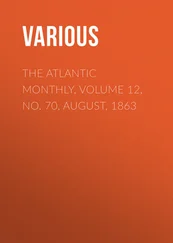Various - The Atlantic Monthly, Volume 12, No. 69, July, 1863
Здесь есть возможность читать онлайн «Various - The Atlantic Monthly, Volume 12, No. 69, July, 1863» — ознакомительный отрывок электронной книги совершенно бесплатно, а после прочтения отрывка купить полную версию. В некоторых случаях можно слушать аудио, скачать через торрент в формате fb2 и присутствует краткое содержание. Жанр: foreign_antique, periodic, foreign_edu, на английском языке. Описание произведения, (предисловие) а так же отзывы посетителей доступны на портале библиотеки ЛибКат.
- Название:The Atlantic Monthly, Volume 12, No. 69, July, 1863
- Автор:
- Жанр:
- Год:неизвестен
- ISBN:нет данных
- Рейтинг книги:4 / 5. Голосов: 1
-
Избранное:Добавить в избранное
- Отзывы:
-
Ваша оценка:
- 80
- 1
- 2
- 3
- 4
- 5
The Atlantic Monthly, Volume 12, No. 69, July, 1863: краткое содержание, описание и аннотация
Предлагаем к чтению аннотацию, описание, краткое содержание или предисловие (зависит от того, что написал сам автор книги «The Atlantic Monthly, Volume 12, No. 69, July, 1863»). Если вы не нашли необходимую информацию о книге — напишите в комментариях, мы постараемся отыскать её.
The Atlantic Monthly, Volume 12, No. 69, July, 1863 — читать онлайн ознакомительный отрывок
Ниже представлен текст книги, разбитый по страницам. Система сохранения места последней прочитанной страницы, позволяет с удобством читать онлайн бесплатно книгу «The Atlantic Monthly, Volume 12, No. 69, July, 1863», без необходимости каждый раз заново искать на чём Вы остановились. Поставьте закладку, и сможете в любой момент перейти на страницу, на которой закончили чтение.
Интервал:
Закладка:
If you wish to see the very look your friend wore when his portrait was taken, let not the finishing artist's pencil intrude within the circle of the vital knot of expression.
We have learned many curious facts from photographic portraits which we were slow to learn from faces. One is the great number of aspects belonging to each countenance with which we are familiar. Sometimes, in looking at a portrait, it seems to us that this is just the face we know, and that it is always thus. But again another view shows us a wholly different aspect, and yet as absolutely characteristic as the first; and a third and a fourth convince us that our friend was not one, but many, in outward appearance, as in the mental and emotional shapes by which his inner nature made itself known to us.
Another point which must have struck everybody who has studied photographic portraits is the family likeness that shows itself throughout a whole wide connection. We notice it more readily than in life, from the fact that we bring many of these family-portraits together and study them more at our ease. There is something in the face that corresponds to tone in the voice,—recognizable, not capable of description; and this kind of resemblance in the faces of kindred we may observe, though the features are unlike. But the features themselves are wonderfully tenacious of their old patterns. The Prince of Wales is getting to look like George III. We noticed it when he was in this country; we see it more plainly in his recent photographs. Governor Endicott's features have come straight down to some of his descendants in the present day. There is a dimpled chin which runs through one family connection we have studied, and a certain form of lip which belongs to another. As our cheval de bataille stands ready saddled and bridled for us just now, we must indulge ourselves in mounting him for a brief excursion. This is a story we have told so often that we should begin to doubt it but for the fact that we have before us the written statement of the person who was its subject. His professor, who did not know his name or anything about him, stopped him one day after lecture and asked him if he was not a relation of Mr. –, a person of some note in Essex County.—Not that he had ever heard of.—The professor thought he must be,—would he inquire?—Two or three days afterwards, having made inquiries at his home in Middlesex County, he reported that an elder member of the family informed him that Mr. –'s great-grandfather on his mother's side and his own great-grandfather on his father's side were own cousins. The whole class of facts, of which this seems to us too singular an instance to be lost, is forcing itself into notice, with new strength of evidence, through the galleries of photographic family-portraits which are making everywhere.
In the course of a certain number of years there will have been developed some new physiognomical results, which will prove of extreme interest to the physiologist and the moralist. They will take time; for, to bring some of them out fully, a generation must be followed from its cradle to its grave.
The first is a precise study of the effects of age upon the features. Many series of portraits taken at short intervals through life, studied carefully side by side, will probably show to some acute observer that Nature is very exact in the tallies that mark the years of human life.
The second is to result from a course of investigations which we would rather indicate than follow out; for, if the student of it did not fear the fate of Phalaris,—that he should find himself condemned as unlifeworthy upon the basis of his own observations,—he would very certainly become the object of eternal hatred to the proprietors of all the semi-organizations which he felt obliged to condemn. It consists in the study of the laws of physical degeneration,—the stages and manifestations of the process by which Nature dismantles the complete and typical human organism, until it becomes too bad for her own sufferance, and she kills it off before the advent of the reproductive period, that it may not permanently depress her average of vital force by taking part in the life of the race. There are many signs that fall far short of the marks of cretinism,—yet just as plain as that is to the visus eruditus ,—which one meets every hour of the day in every circle of society. Many of these are partial arrests of development. We do not care to mention all which we think may be recognized, but there is one which we need not hesitate to speak of from the fact that it is so exceedingly common.
The vertical part of the lower jaw is short, and the angle of the jaw is obtuse, in infancy. When the physical development is complete, the lower jaw, which, as the active partner in the business of mastication, must be developed in proportion to the vigor of the nutritive apparatus, comes down by a rapid growth which gives the straight-cut posterior line and the bold right angle so familiar to us in the portraits of pugilists, exaggerated by the caricaturists in their portraits of fighting men, and noticeable in well-developed persons of all classes. But in imperfectly grown adults the jaw retains the infantile character,—the short vertical portion necessarily implying the obtuse angle. The upper jaw at the same time fails to expand laterally: in vigorous organisms it spreads out boldly, and the teeth stand square and with space enough; whereas in subvitalized persons it remains narrow, as in the child, so that the large front teeth are crowded, or slanted forward, or thrown out of line. This want of lateral expansion is frequently seen in the jaws, upper and lower, of the American, and has been considered a common cause of caries of the teeth.
A third series of results will relate to the effect of character in moulding the features. Go through a "rogues' gallery" and observe what the faces of the most hardened villains have in common. All these villanous looks have been shaped out of the unmeaning lineaments of infancy. The police-officers know well enough the expression of habitual crime. Now, if all this series of faces had been carefully studied in photographs from the days of innocence to those of confirmed guilt, there is no doubt that a keen eye might recognize, we will not say the first evil volition in the change it wrought upon the face, nor each successive stage in the downward process of the falling nature, but epochs and eras, with differential marks, as palpable perhaps as those which separate the aspects of the successive decades of life. And what is far pleasanter, when the character of a neglected and vitiated child is raised by wise culture, the converse change will be found—nay, has been found—to record itself unmistakably upon the faithful page of the countenance; so that charitable institutions have learned that their strongest appeal lies in the request, "Look on this picture, and on that,"—the lawless boy at his entrance, and the decent youth at his dismissal.
The field of photography is extending itself to embrace subjects of strange and sometimes of fearful interest. We have referred in a former article to a stereograph in a friend's collection showing the bodies of the slain heaped up for burial after the Battle of Malignano. We have now before us a series of photographs showing the field of Antietam and the surrounding country, as they appeared after the great battle of the 17th of September. These terrible mementos of one of the most sanguinary conflicts of the war we owe to the enterprise of Mr. Brady of New York. We ourselves were on the field upon the Sunday following the Wednesday when the battle took place. It is not, however, for us to bear witness to the fidelity of views which the truthful sunbeam has delineated in all their dread reality. The photographs bear witness to the accuracy of some of our own sketches in a paper published in the December number of this magazine. The "ditch" is figured, still encumbered with the dead, and strewed, as we saw it and the neighboring fields, with fragments and tatters. The "colonel's gray horse" is given in another picture just as we saw him lying.
Читать дальшеИнтервал:
Закладка:
Похожие книги на «The Atlantic Monthly, Volume 12, No. 69, July, 1863»
Представляем Вашему вниманию похожие книги на «The Atlantic Monthly, Volume 12, No. 69, July, 1863» списком для выбора. Мы отобрали схожую по названию и смыслу литературу в надежде предоставить читателям больше вариантов отыскать новые, интересные, ещё непрочитанные произведения.
Обсуждение, отзывы о книге «The Atlantic Monthly, Volume 12, No. 69, July, 1863» и просто собственные мнения читателей. Оставьте ваши комментарии, напишите, что Вы думаете о произведении, его смысле или главных героях. Укажите что конкретно понравилось, а что нет, и почему Вы так считаете.












